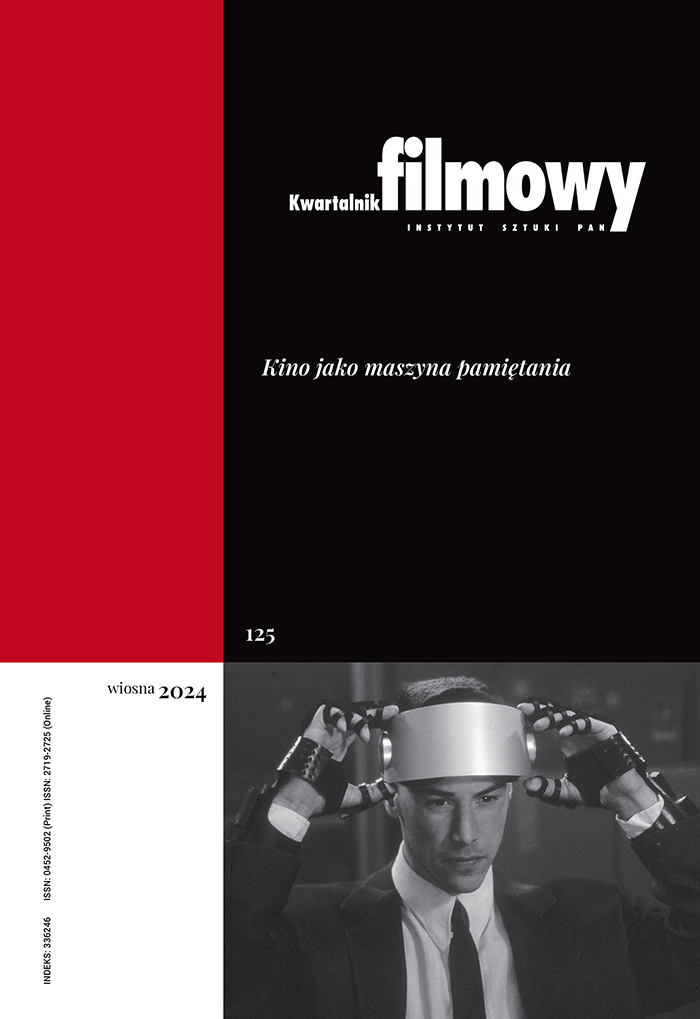Między mitem i historią jest realność zła. „Ryś” Stanisława Różewicza
Abstrakt
Film Ryś Stanisława Różewicza, skoncentrowany na ukazaniu realności zła, znosi granicę między jego mitycznym wyobrażeniem i historycznym zaistnieniem. Widz w obrazie Różewicza jest konfrontowany z dwoma radykalnymi przejawami zła, opierającymi się na przeciwnych sytuacjach wolności ludzkiej woli. Pierwszy z nich nawiązuje do specyfiki biblijnego mitu „adamickiego”, koncentrującego się na antropologicznych zjawiskach ulegania złu w perspektywie indywidualnej. Drugi, związany z doświadczeniem Shoah, poświadcza nie tylko zło człowieka, ale przede wszystkim ludzi, w swym społecznym, systemowym wymiarze. Wizualna narracja w filmie stanowi nieustanną konfrontację obu tych aspektów realności zła, potwierdzając wzajemne ich uwikłanie, współzależność, niepoddającą się prostej racjonalizacji. Z tej właśnie perspektywy teza o banalności zła wydaje się nie do przyjęcia.
Słowa kluczowe:
Stanisław Różewicz, mit, zło, HolokaustBibliografia
Arendt Hannah, Eichmann w Jerozolimie. Rzecz o banalności zła, tłum. A. Szostkiewicz, Kraków 1998, s. 402.
Google Scholar
Biblia Tysiąclecia, tłum. zb., Pallottinum, Poznań – Warszawa 1980.
Google Scholar
Bierdiajew Mikołaj, Sens historii. Filozofia losu człowieka, tłum. H. Paprocki, Wydawnictwo Antyk, Kęty, 2002, s. 128,136.
Google Scholar
Bonhoeffer Dietrich, Ethik, Chr. Kaiser Verlag, München 1985, s. 226.
Google Scholar
Hendrykowski Marek, Stanisław Różewicz, Ars Nova, Poznań 1999, s. 100-103.
Google Scholar
Iwaszkiewicz Jarosław, Brzezina i inne opowiadania ekranizowane, Czytelnik, Warszawa 1987, s. 461, 463, 479, 482.
Google Scholar
Maszewska-Łupiniak Monika, Rzeczywistość filmowa Stanisława Różewicza, Wyd. UJ, Kraków 2009, s. 155-181.
Google Scholar
Ricoeur Paul, Symbolika zła, tłum S. Cichowicz, M. Ochab, Instytut Wyd. Pax, Warszawa 1986, s. 16, 222, 233.
Google Scholar
Stróżewski Władysław, Istnienie i sens, Znak, Kraków 1994, s. 7.
Google Scholar
Autorzy
Waldemar Frąckwartalnik.filmowy@ispan.pl
Uniwersytet Jagielloński Polska
Absolwent filmoznawstwa i filozofii UJ, adiunkt w Zakładzie Teorii Filmu w Instytucie Sztuk Audiowizualnych UJ, członek redakcji czasopisma Komitetu Nauk o Kulturze PAN „Przegląd Kulturoznawczy”. Opublikował Kino możliwe (2003) oraz artykuły m.in. w „Kwartalniku Filmowym”, „Principiach”, „Przeglądzie Kulturoznawczym”, „Ethosie” oraz tomach zbiorowych.
Statystyki
Abstract views: 261PDF downloads: 136
Licencja
Prawa autorskie (c) 2012 Waldemar Frąc

Utwór dostępny jest na licencji Creative Commons Uznanie autorstwa 4.0 Międzynarodowe.
Autor bądź autorka udziela wydawcy niewyłącznej i nieodpłatnej licencji (CC BY 4.0) na wykorzystanie tekstu w „Kwartalniku Filmowym”, zachowuje nieograniczone prawa autorskie i zobowiązuje się do podawania miejsca pierwodruku przy ponownym wykorzystaniu artykułu (umowa licencyjna do pobrania). Czasopismo jest wydawane na licencji CC BY 4.0. Zgłaszając artykuł do publikacji, autor bądź autorka wyraża zgodę na jego udostępnianie na tej licencji.
W wydaniach od 105-106 (2019) do 119 (2022) wszystkie artykuły były publikowane na licencji CC BY-NC-ND 4.0. W tym okresie autorzy i autorki udzielali(-ły) niewyłącznej i nieodpłatnej licencji (CC BY-ND 4.0) na wykorzystanie tekstu w „Kwartalniku Filmowym”, zachowywali(-ły) nieograniczone prawa autorskie i zobowiązywali(-ły) się do podawania miejsca pierwodruku przy ponownym wykorzystaniu artykułu.
Inne teksty tego samego autora
- Waldemar Frąc, Kino i twarda rzeczywistość , Kwartalnik Filmowy: Nr 75-76 (2011): Oblicza rzeczywistości
- Waldemar Frąc, Obiektywizm subiektywnych pragnień. Transcendencja zmysłowości w „Uczcie Babette” Gabriela Axela , Kwartalnik Filmowy: Nr 66 (2009): Kino złego smaku – kino dobrego smaku
- Waldemar Frąc, Obraz czasu w samotności. „Pętla” Wojciecha Jerzego Hasa , Kwartalnik Filmowy: Nr 43 (2003): Kino polskie wczoraj i dziś
- Waldemar Frąc, Cielesność filmu, filmowość ciała , Kwartalnik Filmowy: Nr 83-84 (2013): Ciało w filmie
- Waldemar Frąc, Śmierć ciała. Pytanie o człowieka – „Życie jako śmiertelna choroba przenoszona drogą płciową” Krzysztofa Zanussiego , Kwartalnik Filmowy: Nr 47-48 (2004): Antropologia i film
- Waldemar Frąc, Kino: pytanie rzeczy , Kwartalnik Filmowy: Nr 74 (2011): Rzeczy filmowe
- Waldemar Frąc, Dotknięcie śmierci obrazem – potrzeba sensu. „Wykonać wyrok” Stephena Frearsa , Kwartalnik Filmowy: Nr 53 (2006): Kino brytyjskie (cz. II)











